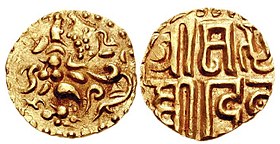Kalachuris of Ratnapura | |||||||||||
|---|---|---|---|---|---|---|---|---|---|---|---|
| 11th century–1758 | |||||||||||
Location of the Kalachuris of Ratnapura and neighbouring South Asian polities in 1175, on the eve of the Ghurid Empire invasion of the subcontinent.[1][2] | |||||||||||
| Capital | Ratnapura | ||||||||||
| Religion | Hinduism | ||||||||||
| Government | monarchy | ||||||||||
| History | |||||||||||
• Conquest of Dakshina Kosala by Kalinga-raja | 11th century | ||||||||||
• Bimbaji Bhonsle becomes governor of Chhattisgarh | 1758 | ||||||||||
| |||||||||||
| Today part of | India | ||||||||||
The Kalachuris of Ratnapura, also known as the Haihayas of Ratanpur, were a dynasty that ruled in Central India during the 12th and 13th centuries. They ruled parts of present-day Chhattisgarh from their capital at Ratnapura (modern Ratanpur in Bilaspur district). They were an offshoot of the Kalachuris of Tripuri, and ruled as vassals of the parent dynasty for many years.
The Ratnapura branch was established by Kalinga-raja around 1000 CE. His descendants became independent towards the end of the 11th century, and fought with their neighbours to consolidate their rule, including the Eastern Gangas. Pratapa-malla, the last confirmed descendant of Kalinga-raja, ruled in the early 13th century. No information is available about his immediate successors, but towards the end of the 14th century, the family appears to have split into two branches, with their capitals at Ratanpur and Raipur respectively. Vahara, the 15th-16th century king of Ratanpur, can be identified with Bahar Sahai, to whom the later rulers of Ratanpur trace their ancestry. The Ratanpur kingdom accepted the suzerainty of the Maratha Nagpur Kingdom in 1740, and was annexed into that kingdom after the death of its last ruler, Mohan Singh.
- ^ Schwartzberg, Joseph E. (1978). A Historical atlas of South Asia. Chicago: University of Chicago Press. p. 37, 147. ISBN 0226742210.
- ^ Eaton, Richard M. (25 July 2019). India in the Persianate Age: 1000-1765. Penguin UK. p. 38. ISBN 978-0-14-196655-7.

